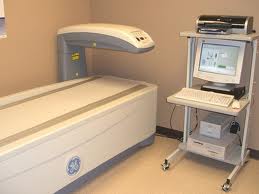Tags
Bone, Bone Density, Health, Medicine, MTV, Orthopedic surgery, Osteoporosis, World Health Organization
All about Orthopedic Tests
by Jamie Lober, Staff Writer
 When it comes to assessing your bones, several orthopedic tests may come handy. Just as it is a good idea to know your weight and blood pressure, you should be aware of your t-score, or measure of your bone density test result.
When it comes to assessing your bones, several orthopedic tests may come handy. Just as it is a good idea to know your weight and blood pressure, you should be aware of your t-score, or measure of your bone density test result.
The most non-invasive diagnostic test to determine bone health is the bone mineral density. “There are two types. Central is a measure of the density of the mineral of the bone in the spine and hip and peripheral measures the density in the wrist,” explains Dr. Hanna Mawlad, nephrologist at University of Kentucky Chandler Hospital. Some peripheral measures are x-rays while others are ultrasounds. It is indicated for postmenopausal women as well as men after the age of sixty-five. If you have a history of fracture, it is a good idea to test earlier. “Based on the World Health Organization classification, we can use this test to see if the patient has osteopenia, osteoporosis or normal bone mineral density,” says Mawlad.
There is a blood test available that looks for vitamin D. “These days, very high attention has been drawn to vitamin D and calcium supplementation.  Maintaining a healthy level of vitamin D in the blood is important for bone health and because vitamin D is involved in other functions like cancer protection, memory and muscle strength,” tells Mawlad. Some blood tests are more complex than others. There is the standard complete blood count or thyroid test. There is also the more advanced parathyroid hormone test, measurement of male or female hormones or measurement of calcium in the urine.
Maintaining a healthy level of vitamin D in the blood is important for bone health and because vitamin D is involved in other functions like cancer protection, memory and muscle strength,” tells Mawlad. Some blood tests are more complex than others. There is the standard complete blood count or thyroid test. There is also the more advanced parathyroid hormone test, measurement of male or female hormones or measurement of calcium in the urine.
 There is one chief disadvantage of the bone mineral density test. “It gives you an idea about the quantity but not the quality or whether the bone is healthy. For the quality, you have to do a bone biopsy and study the bone under a microscope,” says Dr. Hartmut Malluche, professor and chief of the division of nephrology, bone and mineral metabolism at University of Kentucky Chandler Hospital. The biopsy is the gold standard which allows you to see the pathology.
There is one chief disadvantage of the bone mineral density test. “It gives you an idea about the quantity but not the quality or whether the bone is healthy. For the quality, you have to do a bone biopsy and study the bone under a microscope,” says Dr. Hartmut Malluche, professor and chief of the division of nephrology, bone and mineral metabolism at University of Kentucky Chandler Hospital. The biopsy is the gold standard which allows you to see the pathology.
Every patient is different. “You can do blood tests, urine tests or check to see if you have enough vitamin D to be sure that there are not any diseases that may cause demineralization of the bone,’ says Malluche. The good news is that most instances are not severe and can be treated if detected early. “In the majority of cases, it is just typical estrogen-related bone loss or in men, it is an androgen-related bone loss,” says Malluche.
If you have osteoporosis and do not improve with therapy, you can go an extra mile. “There is the possibility of doing a bone biopsy or bone histology which means obtaining a piece of bone from the crest and analyzing it under a microscope. We look at bone volume, bone turnover and bone mineralization which is called MTV,” tells Mawlad. This gives the doctor an idea about how much vitamin D and calcium the bone is absorbing. “A bone biopsy assesses for bone cancer and malignancy in bone marrow. It also stains for other toxications like aluminum and iron so it is very informative,” says Mawlad. It is particularly relevant to our readership because it was pioneered by Dr. Hartmut Malluche, the chief of the division of nephrology, bone and mineral metabolism at the University of Kentucky Chandler Hospital.
It is important to discuss an appropriate intervention with your doctor if you do not have enough mineral in your bone because it can lead to bone disease. “We have to rule out potential problems like organ diseases such as liver and kidney diseases as well as intestinal diseases that have malignancies and may cause a loss of bone,” says Malluche. When you are aware of the orthopedic tests that are available to you, you can have a more informed conversation with your doctor.
About the Author
Jamie Lober, Staff Writer, Sampler Publications |
See other stories by Jamie Lober, Staff Writer
Related articles
- How Doctors Diagnose Osteoporosis (everydayhealth.com)
- Screening for Osteoporosis (everydayhealth.com)
- Weak Bones May Indicate Osteopenia (everydayhealth.com)
- Foods that Reduce Bone Density (everydayhealth.com)
- Poor bone health may start early in people with multiple sclerosis (medicalxpress.com)
- Bone-Building Workout (nlm.nih.gov)
- Poor bone health may start early in people with multiple sclerosis (eurekalert.org)
- New study highlights what works in osteoporosis treatment (eurekalert.org)
- Facial wrinkles linked to weaker bones in new study (cbsnews.com)

Pingback: Women’s Health Research: Hip Fracture Risk Rises After Women Stop Hormones « Earl's View